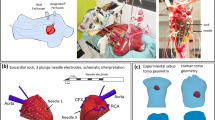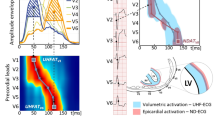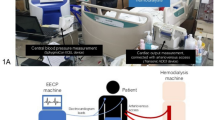Abstract
Purpose
To study the naturally occurring kinetic characteristics of corneal surface.
Methods
The right eyes of three subjects (young, early presbyope, and presbyope) were examined. Cardiac signal and longitudinal corneal apex movements were simultaneously measured with electrocardiography (ECG) and a high-speed videokeratoscope, respectively. Time, frequency, and combined time–frequency representations of the acquired signals were derived to establish their temporal and spectral contents. Coherence analysis was used to assess the correlation between the corneal apex velocities and the cardiopulmonary system.
Results
In all measurements, longitudinal corneal apex velocity signals showed close correlation with the corresponding ECG signals. The signatures of the pulse frequency, which was inferred from the ECG spectra and their variations in time, were clearly visible in the spectral content of corneal apex velocities. For the young subject, the correlation was the strongest and all of the spectral content of the pulse signal including the harmonics was propagating to the corneal apex velocities. For the other two subjects, there was a clear propagation of the pulse signal itself but not of all pulse harmonics.
Conclusions
Longitudinal movements of the corneal apex are closely related to the cardiopulmonary system. The differences in propagation of pulse harmonics to the corneal apex velocities for different subjects suggest that the frequency characteristics of apex velocity could be related to pulsative variations in the intraocular pressure and biomechanical properties of the eye. These findings could potentially be used in noninvasive assessment of the hemodynamic status of the eye with high-speed videokeratoscopy.
Similar content being viewed by others
Log in or create a free account to read this content
Gain free access to this article, as well as selected content from this journal and more on nature.com
or
References
Flammer J, Orgul S, Costa VP, Orzalesi N, Krieglstein GK, Serra LM et al. The impact of ocular blood flow in glaucoma. Progr Retin Eye Res 2002; 21: 359–393.
Evans DW, Hosking SL, Embleton SJ, Morgan AJ, Bartlett JD . Spectral content of the intraocular pressure pulse wave: glaucoma patients versus normal subjects. Graefe's Arch Clin Exp Ophthalmol 2002; 240: 475–480.
Barnes RW . Noninvasive evaluation of the carotid bruit. Annu Rev Med 1980; 31: 201–218.
Perkins ES . The ocular pulse and intraocular pressure as a screening test for carotid artery stenosis. Br J Ophthalmol 1985; 69: 676–680.
Claridge KG, James CB . Ocular pulse measurements to assess pulsatile blood flow in carotid artery disease. Br J Ophthalmol 1994; 78: 321–323.
Krakau CE, Lindberg S, Havelius U . An instrument for recording the ocular pulse wave. Acta Ophthalmol Scand 1995; 73: 472–474.
Kartchner MM, McRae LP, Morrison FD . Noninvasive detection and evaluation of carotid occlusive disease. Arch Surg 1973; 106: 528–535.
Hoffmann EM, Grus F-H, Pfeiffer N . Intraocular pressure and ocular pulse amplitude using dynamic contour tonometry and contact lens tonometry. BMC Ophthalmol 2004; 4: 1:4.
Vogel A, Beck S, Schwenn O, Grus F, Krummenauer F, Pfeiffer N . Reproducibility of measurement of ocular pulse amplitude and intraocular pressure using Smartlens. Der Ophthalmol 2001; 98: 944–949.
Northrop RB, Nilakhe SS . A no-touch ocular pulse measurement system for the diagnosis of carotid occlusions. IEEE Trans Biomed Eng 1977; 24: 139–148.
Campagna DP, Drake AD . Interferometric measurement of the ocular pulse. In: The Proceedings of the 14th Annual Northeast Bioengineering Conference. University of Hampshire, Durham, 10–11 March, 1988, pp 118–121.
Aburn NS . Orbital color Doppler imaging. Eye 1993; 7: 639–647.
Sullivan P, Cioffi GA, Wang L, Johnson CA, Van Buskirk EM, Sherman KR et al. The influence of ocular pulsatility scanning laser Doppler flowmetry. Am J Ophthalmol 1999; 128: 81–87.
Astakhov YS, Irkaev SM, Rzhanov BI . Gamma resonance velocimetry of the eye. Vestn Oftalmol 1989; 10: 59–62 (in Russian).
Trew DR, James CB, Thomas SH, Sutton R, Smith SE . Factors influencing the corneal pulse—the hear rate. Graefe's Arch Clin Exp Ophthalmol 1991; 229: 553–556.
Bosley TM, Cohen MS, Gee W, Reed III J, Sergott RC, Savino PJ . Amplitude of the ocular pneumoplethysmography waveform is correlated with cardiac output. Stroke 1993; 24: 6–9.
Eisenlohr JE, Langham ME . The relationship between pressure and volume changes in living and dead rabbit eyes. Invest Ophthalmol 1962; 1: 63–77.
Kasprzak H, Forster W, von Bally G . Measurement of elastic modulus of the bovine cornea by means of holographic interferometry. Part 1. Method and experiment. Opt Vision Sci 1993; 70: 535–544.
Forster W, Kasprzak H, von Bally G . Measurement of elastic modulus of the central bovine cornea by means of holographic interferometry. Part II. Results. Optometry Vision Sci 1994; 71: 27–32.
Hjortdal J . Regional elastic performance of the human cornea. J Biomech 1996; 29: 931–942.
Michelson G, Harazny J . Relationship between ocular pulse pressures and retinal vessel velocities. Ophthalmology 1997; 104: 664–671.
Iskander DR, Collins MJ . Applications of high speed videokeratoscopy. Clin Exp Opt 2005; 88: 223–231.
Zhu M, Collins MJ, Iskander DR . Dynamics of ocular surface topography. Eye 2006 (advance online publication, April 21; doi:10.1038/sj.eye.6702293).
Iskander DR, Kasprzak HT . Dynamics in longitudinal eye movements and corneal shape. Ophthal Physiol Opt 2006; (in press).
Conover MB . Electrocardiography, Mosby's Pocket Guide Series Mosby Inc.: St Louis, MO, 2004.
Iskander DR, Collins MJ, Davis B . Evaluating tear film stability in the human eye with high speed videokeratoscopy. IEEE Trans Biomed Eng 2005; 52: 1939–1949.
Baillard C, Gonçalves P, Mangin L, Swynghedauw B, Mansier P . Use of time frequency analysis to follow transitory modulation of the cardiac autonomic system in clinical studies. Auton Neurosci Basic Clin 2001; 90: 24–28.
Cerutti S, Bianchi AM, Mainardi LT . Advanced spectral methods for detecting dynamic behaviour. Auton Neurosci Basic Clin 2001; 90: 3–12.
Iskander DR, Collins MJ, Morelande MR, Zhu M . Analyzing the dynamic wavefront aberrations in human eye. IEEE Trans Biomed Eng 2004; 51: 1969–1980.
Zhao Y, Atlas LE, Marks RJ . The use of cone-shaped kernels for generalized time–frequency representations of nonstationary signals. IEEE Trans Acoust Speech Signal Process 1990; 38: 1084–1091.
Winn B, Pugh JR, Gilmartin B, Owens B . Arterial pulse modulates steady-state ocular accommodation. Curr Eye Res 1990; 9: 971–975.
Collins MJ, Davis B, Wood J . Microfluctuations of steady-state accommodation and the cardiopulmonary system. Vision Res 1995; 35: 2491–2502.
Doughty MJ . Consideration of three types of spontaneous eye blink activity in normal humans: during reading and video display terminal use, in primary gaze, and while in conversations. Opt Vision Sci 2001; 78: 712–725.
Savitzky A, Golay MJE . Smoothing and differentiation of data by simplified least squares procedures. Anal Chem 1964; 36: 1627–1639.
Eadie AS, Pugh JR, Winn B . The use of coherence functions in the study of ocular mechanism. Ophthal Physiol Opt 1995; 15: 311–317.
James CB, Trew DR, Clark K, Smith SE . Factors influencing the corneal pulse—axial length. Graefe's Arch Clin Exp Ophthalmol 1991; 229: 341–344.
Wang X, Sun HH, Van De Water JM . An advanced signal processing technique for impedance cardiography. IEEE Trans Biomed Eng 1995; 42: 224–230.
Nichols WW, Conti CR, Walker WE, Milnor WR . Input impedance of the systemic circulation in man. Circ Res 1977; 40: 451–458.
Shakin EP, Bosley TM, Gee W, Reed III J, Brown GC, Sergott RC et al. Abnormal ocular pneumoplethysmographic results in unilateral neovascular glaucoma. Arch Neurol 1989; 46: 1308–1310.
Acknowledgements
This work was partially supported by the 2005 QUT Visiting Fellowship grant. We thank Michael Collins for his advice on this paper.
Author information
Authors and Affiliations
Corresponding author
Rights and permissions
About this article
Cite this article
Kasprzak, H., Iskander, D. Spectral characteristics of longitudinal corneal apex velocities and their relation to the cardiopulmonary system. Eye 21, 1212–1219 (2007). https://doi.org/10.1038/sj.eye.6702578
Received:
Accepted:
Published:
Issue date:
DOI: https://doi.org/10.1038/sj.eye.6702578
Keywords
This article is cited by
-
The effect of changes in cardiovascular activity on corneal biomechanics and pulsation in rabbits
Scientific Reports (2020)
-
The Bull’s Eye Pattern of the Tear Film in Humans during Visual Fixation on En-Face Optical Coherence Tomography
Scientific Reports (2019)
-
Changes in spectral parameters of corneal pulse following canaloplasty
Graefe's Archive for Clinical and Experimental Ophthalmology (2019)
-
Clinical utility of spectral analysis of intraocular pressure pulse wave
BMC Ophthalmology (2014)



